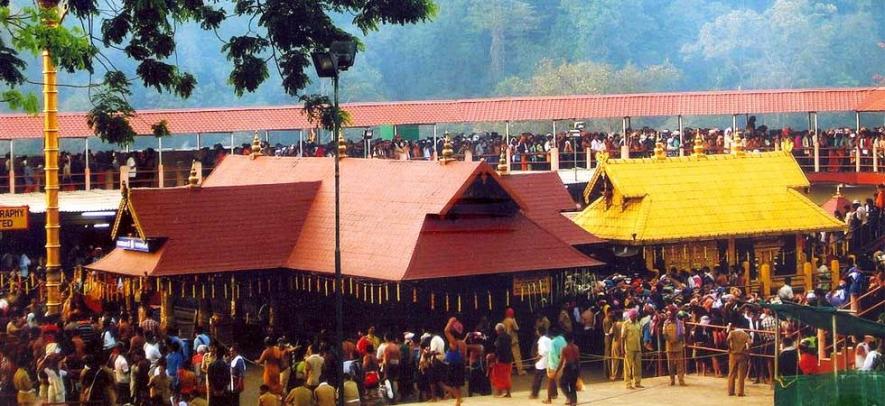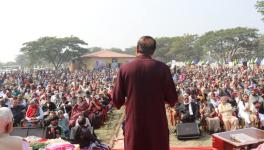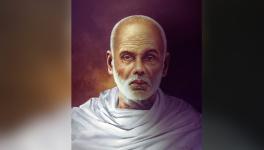Left and Progressive Outfits Counter “Save Sabarimala” Protests With Historical Facts

As the protests continue in Kerala’s Sabarimala against the Supreme Court verdict allowing the entry of women irrespective of age, a large section of the devotees along with the public are worried about the tense atmosphere prevailing in the premises of the temple, and in the state.
The protesters, who have united under the ‘Save Sabarimala’ banner, have been led by the BJP-RSS and Hindutva outfits in the state. However, there is a larger crowd on the other side of the spectrum that is opposing the communal polarisation agenda of the BJP-RSS, Hindutva outfits and Congress. The Left Democratic Front has taken a strong stand in favour of the entry of the women into the Sabarimala temple, and has been conducting mass meetings across the state to bring greater clarity to the issue. The campaign was joined with various political, social and cultural progressive organisations in the state.
Democratic Youth Federation of India (DYFI), Communist Party of India (Marxist) [CPI(M)], Communist Party of India (CPI), Progressive Art Literary Society and All India Democratic Women’s Association (AIDWA) have launched individual campaigns in the state to stand by the SC verdict. The gatherings called ‘Navodhana Sadhassukal’ (roughly translated to Renaissance Audiences) are being held in every nook and corner of the state with a slogan ‘No to a Second Liberation Struggle’.
“DYFI is conducting Navodhana Sadhassukal in every block level to reach out to the youth. In our block, we got an overwhelming response to our programme. Now, the people are aware of the hidden agendas of the demonstrators and political motives behind it,” said Lijith, DYFI’s Kannur District Committee member, while talking about the programme that was organised in his area.
Read More: Using Allahabad, Sabarimala, and Ayodhya to Polarise India!
CPI(M) – the ruling party in the state – is determined to maintain the communal harmony and peace in the state. Conducting grassroots-level campaigns and meetings, the party is fighting the attempts to polarise the common people in the name of religion, sources in the party said.
All of these gatherings revisit how the renaissance movement had broken the age-old customs and rituals that stood as a hindrance to the progress of the society. The rituals and customs which had given legitimacy to the oppression, were abolished during the renaissance movement. As the Chief Minister Pinarayi Vijayan said in one of his public meetings a few days back, the “movements led by Sree Narayana Guru, Ayyankali, Chattambi Swami and other great personalities have in fact drastically changed our state. The left, labour and farmer movements later took up such movements”.
There are several events that can portray how the renaissance movement transformed society. Villuvandi Yathra, Vaikom Satyagraha and Guruvayur Satyagraha are the few among these movements. That means, the agitations against the regressive customs and practices have emerged within the communities.
Read More: Sabarimala: Between Renaissance and Revivalism
In 1893, Ayyankali of Pulaya caste – the then untouchables – rode through the streets of Venganoor on two white bullocks. It was later described as Villuvandi Yathra. During those times, untouchables were barred from using the public streets and ride atop a cart. Of course, the Yathra drew the ire of upper caste Hindus.
“Though, in the past, there was a notion not to intervene in the existing customs of princely states, later we witnessed the national movement. In reality, the state had become a guide for the country through several agitations,” the chief minister had reminded.
Again, the Vaikom Satyagraha of 1924-25 secured rights of all sections of the society to use the public roads leading to the Mahadeva Temple at Vaikom, which paved the way for the Temple Entry Proclamation of the Travancore Government. Seven years later, on November 1, 1931, a large number of Dalits had assembled in Guruvayur, demanding that the lower caste Hindus should be allowed inside the temple. This movement, Guruvayur Satyagraha, was one of the key struggles in the temple entry movement in Kerala.
“Some other protests emerged following the Vaikom Satyagraha like the Guruvayur Satyagraha. It was a result of all this that the state could progress, defeating all the conservative attitudes. The peculiarity in all this is that there were active efforts towards women’s issues as well. This led to finding new paths for the lives of women in the state,” noted Vijayan.
“There were agitations for the right to cover women’s breast, for remarriage of widows and for the right to education for women. It was a continuation of all these that land reforms were implemented. Because of this, the basic elements of feudalism were eliminated from the economic sphere, apart from social and cultural spheres. This is how our land progressed to its current state. Women could make big progress in modern education and employment.”
Read More: Sabrimala: RSS Supremo Justifies Flouting of SC Order
In the context of Sabarimala row, AIDWA has already organised a series of public rallies to defend gender rights. Students Federation of India (SFI) has also joined with the ongoing campaign.
“SFI has floated a campaign in the campuses all over the state on Monday, in an attempt to spread the message that menstruation is not impure. Along with this, we will be conducting renaissance schools too,” said VP Sanu, all India President of SFI.
Get the latest reports & analysis with people's perspective on Protests, movements & deep analytical videos, discussions of the current affairs in your Telegram app. Subscribe to NewsClick's Telegram channel & get Real-Time updates on stories, as they get published on our website.
























